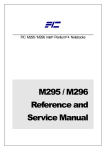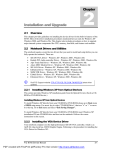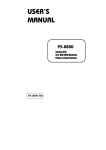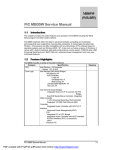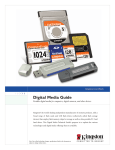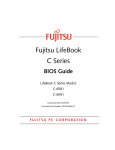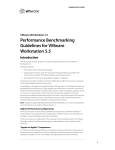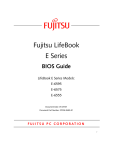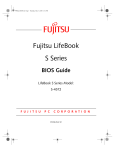Download Medion FLAT PANEL LCD TFT MONITOR Service manual
Transcript
Chapter Outline of the M785 1.1 Introduction This chapter provides the outline features and operation of the M785 including the BIOS Setup program and other system options. The M785 all-in-one notebook offers the latest in advanced portable computing and multimedia technology that even outperforms most desktop computers. It incorporates the latest Intel Pentium 4 Processor running at 400 /533MHz Front Side Bus. It combines support for the new high-bandwidth Double Data Rate (DDR) 266 SDRAM, Integrated VGA and the AC 97 audio codec. Built-in Windows 98 / Me / 2000 / XP keyboard, glide pad pointing device, sound system, PCMCIA slots, USB (Universal Serial Bus) port, advanced power management and more new multimedia features. The Intel® Pentium® 4 processor is the evolutionary step for desktop processor technology. Based on Intel® Net Burst™ micro architecture, the Pentium 4 processor offers higherperformance processing than ever before. Built with Intel's 0.13-micron technology, the Pentium 4 processor delivers significant performance gains for use in home computing, business solutions and all your processing needs. 1.2 Feature Highlights The M785 includes a variety of innovative features: Features CPU Description • Desktop Intel ® Pentium 4 Northwood Processors using uFCPGA packaging at 2.0 / 2.2 / 2.26 / 2.4 / 2.53 GHz • Support FSB 400/533 MHz. Cache Memory • L1 Cache (Pentium Processor internal): 12KB code and 8KB data 8-way cache associatively provides • L2 Cache (Pentium Processor internal): 512KB code and 8KB data 8-way set associative, 32-byte line size, 1 line per sector Bus Architecture 32-bit PCI/PCI-to-ISA Bus Architecture Bus Speed 400/533 MHz Front Side Bus FIC M785 Service Manual PDF created with FinePrint pdfFactory Pro trial version http://www.pdffactory.com 1-1 Outline of the M785 Features System Memory Description • Base Memory: 1 SO-DIMM Slot (1.25”) Size: 128 / 256 / 512MB Type: DDR SDRAM, 2.5V Data Path: 64Bit Frequency: 266MHz Refresh: CBR Refresh • Expansion Memory: 1 SO-DIMM Slot (1.25”) Size: 128 / 256 / 512MB Type: DDR SDRAM, 2.5V Data Path: 64Bit Frequency: 266MHz Refresh: CBR Refresh • Maximum 32-bit True Color display at 1024x768 pixel resolution for 14" TFT LCD • Brightness controls via hot-key function • 15” XGA and SXGA+ TFT support, 14.1” XGA TFT support • Embedded in SIS 650 Chipset • High Performance and high quality 3D accelerator with AGP4X • Integrated VB bridge • High performance 2D accelerator • Complete TV-OUT / Digital Flat Panel Solution • Shared with system memory from 8MB ~ 64MB • Built-in (internal) 2.5-inch Format; 9.5mm in Height Enhanced IDE hard drive • 30 GB or above disk drive options • Supports Bus Mastering Ultra-DMA 66 / 100 feature • Built-in ATAPI IDE 24X+ Speed CD-ROM drive; or • Built-in ATAPI IDE 8X+ Speed DVD-ROM drive; or • Built-in ATAPI IDE 4X+ Speed CD-RW drive ; or • Built-in ATAPI IDE CD-RW/DVD combo drive FDD • External USB 3.5-inch 1.44MB floppy disk drive Keyboard • 19mm Pitch and 3mm Travel • Built-in 87 / 90-key Windows keyboard • Compatible with IBM enhanced 101 / 102-key keyboard Display VGA HDD Optical Device 1-2 FIC M785 Service Manual PDF created with FinePrint pdfFactory Pro trial version http://www.pdffactory.com Outline of the M785 Features Pointing Device PCMCIA Slot I/O Port Description • Integrated Touch pad (Glide pad) with 2 select click buttons and 1 scroll button • PS/2 mouse interface • Single-deck PCMCIA 2.1 card slots that support one Type II PC cards • ENE CB1410 (PCI Card Bus controller) • PC/Card Bus Type II x1 • 32-bit CardBus PCI local bus technology / Supports mixed voltage PC cards (5V and 3.3V) Includes the following standard I/O ports: • Serial port: 1 port (D-Sub 9 pin) • Parallel port: 1 port (D-Sub 25 pin) • VGA CRT port: 1 port (D-Sub 15 pin) • USB port: 3 port (ver 2.0) • Port Bar: Not support • Headphone : 1 Jack • MIC In: 1 Jack • DC In: 1 port • TV out: RCA Jack • LAN: 1 port • Modem I/F: 1 port • IEEE 1394: 1 port FIC M785 Service Manual PDF created with FinePrint pdfFactory Pro trial version http://www.pdffactory.com 1-3 Outline of the M785 Features Audio System Description • 16-bit full-duplex sound controller with software wavetable function and FM stereo synthesizer • AC97 Audio Codec / Compatible with Sound Blaster Pro. AC’97 Revision 2.1 Compliant • Integrated 2 high quality paper cone stereo speakers (>1W) with sound boxes and mono microphone • Includes the following: ü Microphone-in jack (MIC-IN) ü Headphone jack ü Volume thumb-wheel knob control • Universal Auto-switching19V / 90W AC Adapter (100V – 240V) / Auto-charging capability • Rechargeable Li-Ion (4000mAh/14.8V) Battery Pack • Battery Life: 2 hours (Power Management Off) • Charging Time: 1.5~2 hours quick charge (computer off) • ACPI 1.0B Ready • SMM (Intel System Management Mode) fully supported • Suspend-to-RAM and Suspend-to-Disk feature / Auto Suspend hot-key function / Battery Low Auto Suspend • Cover Switch (Suspend/CRT-only) function LED Indicator • 7 x LED Status Indicators for Power Source, Battery Charge, EMail, IDE, Caps Lock, Scroll Lock, Num Lock (LCD x 3 + Machine Base x 4) Modem • MDC 56Kbps Fax / Data Internal Modem with V.90 support LAN • Onboard 10BASE-T and 100BASE-TX LAN Power System Power Management 1-4 FIC M785 Service Manual PDF created with FinePrint pdfFactory Pro trial version http://www.pdffactory.com Outline of the M785 1.3 System Configuration Diagram Figure 1-1 System Configuration Diagram FIC M785 Service Manual PDF created with FinePrint pdfFactory Pro trial version http://www.pdffactory.com 1-5 Outline of the M785 1.4 Quick Tour of the Notebook Please take a moment to become familiar with the location and purpose of every control, the LED status panel, connectors and ports, which are illustrated in this section. It is recommended to first go through the User Guide of the notebook, which is shipped together with the notebook for information on how to operate its features. 1.4.1 Inside the Notebook To open the LCD cover of the notebook, find the cover latch located at the front center of the LCD cover. Push the latch to the right to release and tilt the LCD cover up. Inside, you will see the LCD display panel, keyboard, touch pad, status LED, and power switch. ➊ Power Status LED Indicator ➋ Built-in Stereo Speakers ➌ ➍ Easy Button ➎ Color LCD Panel ➏ ➐ Built-in Stereo Speakers ➑ Keyboard ❾ Figure 1-2 Power On / Resume Button Status LED Indicator GlidePad Pointing Device Inside the Notebook Color LCD Display Panel The notebook comes with several LCD option sizes at 15” SXGA+ (1400x1050) or 14.1” XGA (1024x768) active-matrix TFT color liquid crystal display (LCD). You can adjust and o tilt (up to 180 ) the LCD screen panel to your desired viewing position. The notebook computer comes with a color LCD that you can adjust for a comfortable viewing position. The LCD can be 14.1” TFT color LVDS with 1024x768 XGA (Extended Graphics Array) resolution panels or 15” TFT color LVDS with 1400x1050 resolution. The features of the Color LCD Display are summarized as follows: • TFT color LVDS with 14.1" 1024x768 XGA or 15" 1400x1050 resolution panels. • Capable of displaying 16M colors (32-bit true color) on either size panels. 1-6 FIC M785 Service Manual PDF created with FinePrint pdfFactory Pro trial version http://www.pdffactory.com Outline of the M785 • LVDS display control hot-keys allows you to adjust the brightness of the LCD. • Simultaneous display capability for LCD and external desktop computer monitor. • LCD display can be 14.1” or 15" TFT. The notebook uses SiS®650 Host/Memory controller with AGP4X North Bridge Single Chipset & Built-in High Quality 3D Accelerator VGA graphics controller that owns 8~64MB shared video memory. All LCD models can support 16M colors or maximum 32-bit true color at 1024x768 resolution. The notebook also supports simultaneous display of the LCD with the external VGA monitor. The LCD screen also uses CCFT (Cold Cathode Fluorescent Tube) backlighting which consumes much of the electrical power of the notebook. To save battery power, the system has an advanced power management feature that switches off the LCD when there is no system activity for a predetermined amount of time. You adjust the brightness level of the LCD by pressing the display control hot-keys. You activate the hot-keys by pressing the <Fn> key along with another function key: • • <Fn> + <F8> Key = Increases the brightness of the LCD display <Fn> + <F9> Key = Decreases the brightness of the LCD display Keyboard Panel − Standard QWERTY-key layout and full-sized 87 / 90 keys keyboard with Windows hot-keys, embedded numeric keypad, hot keys, inverted “T” cursor arrow keys, and separate page screen control keys. Wide extra space below the keyboard panel for your wrist or palm to sit-on comfortably during typing. (The keypad F4, F5, F7 on the following keyboard should no words print on it.) − Œ Function Keys • Windows Short-cut Key Figure 1-3 • • ‘ Control Keys Ž Windows Start Menu Key Cursor Control Keys Keyboard Layout The notebook keyboard is a little bit different from a standard desktop keyboard. Aside from the normal alphanumeric characters and the standard keyboard function keys, the FIC M785 Service Manual PDF created with FinePrint pdfFactory Pro trial version http://www.pdffactory.com 1-7 Outline of the M785 notebook keyboard includes an embedded numeric keypad, and special function keys that activates by pressing the <Fn> key together with another key. These special function keys or “hot-keys” allow you to control and adjust some of the functions of the notebook like display controls, power saving features, and others. (1) Function Keys — These function keys, out of <F1> through <F12>, are available on the notebook keyboard. These keys also work together with the <Fn> key to activate special functions. The following function-key combinations are pre-programmed: Hot Key Fn + F3 Function Toggle Display (LCD/CRT/Simul) Fn + F6 Fn + F8 Fn + F9 Speaker On/Off Brightness Increase Brightness Decrease Handler BIOS Handler BIOS Handler Controlled by PMU07 Controlled by PMU07 (2) Control keys – <Ctrl>, <Alt>, <Fn>, and <Shift> keys are controls used in conjunction with other keys to change their functions. To use control keys, press and hold the control key while pressing another key. For example, “Press <Ctrl>+ <C>” means to hold down the <Ctrl> key and type the letter <C>. (3) Windows keys (Windows Start Menu Key) – Use this key to activate the Start Menu of Windows. (4) Shortcut/Application key – provides quick access to shortcut menus. (This key acts like a right mouse button.) (5) Cursor Control keys – Cursor control keys let you position the cursor on the screen where you want. On the screen, the cursor is a blinking underline, block, or vertical bar depending on the application. (6) Typewriter keys – Typewriter keys (also called alphanumeric keys) are used to enter text and characters. Keys with blue print on them behave differently when combined with control keys or the <Fn> key. (7) Numeric Keypad – Pressing <NumLock> on the keyboard activates the embedded numeric keypad numbers and functions printed in blue on top of the keys. When you press <NumLock> again, the keys revert to their normal functions as typewriter keys. Figure 1-4 Embedded Numeric Keypad Integrated Microphone This allows you to instantly record voice annotations (normally saved as WAV files) and later 1-8 FIC M785 Service Manual PDF created with FinePrint pdfFactory Pro trial version http://www.pdffactory.com Outline of the M785 attached them to documents and presentation using the notebook integrated audio system and application software. Since the notebook also supports full-duplex audio capabilities, you can talk to the microphone and at the same time listen to others talk when connected to a speakerphone modem, Internet live chat, or video conferencing. Power Status LED Indicator Located just on TFT LED panel assembly, you will find three LEDs for the power and battery charge status. These LEDs are positioned to be visible even if the LCD cover is closed. Œ Power Indicator • Battery Charging LED Figure 1-5 Ž Mail LED Power Status LED Indicator 1. Power Indicator – lets you know if power to the system is turned on and if system is in Suspend-to-RAM mode. This LED is positioned so that you can see it on both sides whether the LCD panel is opened or closed. − Lights green when the system is powered on using the AC adapter or battery. − Lights green blinking when in Suspend to RAM mode and critically low battery power. We strongly recommend that users create the partition "Save to Disk" (for Win98 only) as this will prevent your data from loss when power is critically low. For Windows version later then Win98, please use hibernation mode instead. 2. Battery Charging LED – lights to indicate battery in charging status. − Lights organge to indicate the battery is charging. − Lights off to indicate the battery is fully charged or no battery installed. 3. Mail LED – Lights green to indicate that a new mail is arrived. Status LED Panel The Status LED Panel keeps you informed of the notebook’s current operating status. Each LED is marked with an icon to designate a system status. Figure 1-6 Status LED Panel Icons FIC M785 Service Manual PDF created with FinePrint pdfFactory Pro trial version http://www.pdffactory.com 1-9 Outline of the M785 Icon Represents Indicates Œ IDE Drive Access This LED will turn on when the system is accessing the hard disk drive (HDD) or CD-ROM / DVD-ROM / CD-RW /Combo. • Caps Lock This LED will turn on when the Caps Lock key is activated. When activated, all alphabet keys typed in will be in upper case or in capital letters. Ž Scroll Lock This LED will turn on when the Scroll Lock key is activated. • Num Lock This LED will turn on when the Num Lock key is activated. When activated, the embedded numeric keypad (blue print numeric keys) will be enabled. Easy Buttons There are three easy buttons, two use for accessing Internet and e-mail functions instantly and easily, the other one lets you define certain functions by yourself. Description of the easy buttons appears in the latter part of this section. Œ Internet Button • E-Mail Button Figure 1-7 Easy Button − Internet Button This technology is designed specifically for providing a very convenient way in connecting Internet only by pressing Internet button as shown in the graphics. For more understanding and interesting, you can refer Section 2.5 of user manual to recognize the driver installation procedures in activating Internet button. − E-mail Button This is the most convenient way to access the outlook 98/2000... just by pressing this button, you can omit several procedures in entering into Outlook environment. 1-10 FIC M785 Service Manual PDF created with FinePrint pdfFactory Pro trial version http://www.pdffactory.com Outline of the M785 Power Button Press the Power button either to power on or power off the system. The Power button is also a “Smart” switch, meaning that it recognizes when the system is in Suspend mode. If in Suspend mode, pressing the Power button will bring it out of Suspend mode and resume to the system’s last state. You can set the function of power button from the power management setting in Windows Control Panel. Always check the Power LED after pressing the power button to know the power status of the notebook. o If you are unable to power off the system, use the power override function. Press the power button and hold it in place for four seconds. The system will then power off. Touch Pad Pointing Device Built in just below the keyboard panel is the glide pad pointing device. The left and right select buttons of the glide pad is found below the glide pad surface. The left select button is configured (by default) as the left button you normally click on the left button of your mouse, while the right select key is configured as the right mouse button. The scroll button makes it easy to browse upwards or downwards in the software screen. To move cursor, place your finger lightly on the glide pad and move in the desired direction. If you reach the end of the pad, lift your finger and place it back down on the other side. The glide pad is compatible with the standard PS/2 mouse and can be activated using the normal DOS or Windows PS/2 mouse driver. You can also disable the glide pad in the BIOS Setup program. o You can execute a left button click function by simply tapping on the glide pad surface once. Refer to the User Guide of the notebook for more information. Built-in Stereo Speakers At the front left and right sides of the base unit are two built-in stereo mini speakers with sound boxes. The speakers are controlled by the audio controller of the notebook and activated by installing the audio driver. For adjusting the volume of the speakers, you can use the volume control program under Microsoft OS or by adjusting the thumb-wheel volume knob also found on the right side of the notebook. FIC M785 Service Manual PDF created with FinePrint pdfFactory Pro trial version http://www.pdffactory.com 1-11 Outline of the M785 1.4.2 Front Side of the Notebook Œ CD-ROM, DVD-ROM, CD-RW/DVD Combo Figure 1-8 • Cover Switch Front Side of the Notebook Cover Switch The Cover Switch is found inside the notebook assembly just underneath the latch opening where you insert the LCD cover hook. Whenever the LCD cover is closed, it activates the Suspend mode or shut down the computer. The action can be set on Power Option of Windows Control Panel. o When Suspend-to-RAM mode is activated, make sure not to leave the system for a long period when running at battery mode. The battery will continue to drain some power even in Suspend mode. It is better to save all files and shutdown the power instead or run Suspend-to-Disk mode. CD-ROM, DVD-ROM, CD-RW, CD-RW/DVD Combo Allows you to load and start programs from a compact disc (CD) or a digital video disc (DVD) and play conventional audio CDs. 1.4.3 The Right Side of the Notebook Œ Air-Outlet Vent Figure 1-9 • Locking Device Keyhole Right Side of the Notebook Air Inhalant Inhale the air into your computer to keep it within operating temperature 1-12 FIC M785 Service Manual PDF created with FinePrint pdfFactory Pro trial version http://www.pdffactory.com Outline of the M785 1.4.4 The Left Side of the Notebook Œ • IR Port • Microphone Jack Volume Control ➎ PC Card Slots Figure 1-10 Ž Headphone Jack Left Side of the Notebook IR Port Wireless data transfer of files between your notebook computer and an IR-equipped device or notebook computer. You can also print to an IR-equipped printer without using cables. The SIR mode provides up to 115.2Kbps of data transfer rate Microphone Jack Allows you to connect an external microphone for monophonic sound recording directly into your notebook computer. Plugging in an external microphone disables the built-in microphone. Headphone Jack Lets you plug in a stereo headphone, powered speakers, or earphone set with 1/8 inch phono plug or SPDIF connector for personal listening Volume Control Allows you to control the speaker volume PC Card Slots 1.4.5 The Rear Side of the Notebook Œ • ’ ➓ AC Power Port Parallel Port USB Port Modem Port Figure 1-11 • • “ Air Inhalant Serial Port IEEE 1394 Port Ž ‘ ” CRT Port TV-Out Port LAN Port Rear Side of the Notebook FIC M785 Service Manual PDF created with FinePrint pdfFactory Pro trial version http://www.pdffactory.com 1-13 Outline of the M785 AC Power Port Lets you attach the notebook to the AC power source using the AC adapter that comes with your system. Keep the system connected to AC power whenever possible to keep the battery pack and internal CMOS battery charged. The Battery Charge LED will activate whenever the battery is being recharged. Parallel Port Use this port to connect a parallel printer or other parallel device. The parallel port supports Enhanced Capabilities Port (ECP) standard. The standard provides you with a greater processing speed than the conventional parallel port. The port also supports Bi-directional and EPP protocols. o The default setting for the parallel port on your notebook computer is set to Enhanced Capabilities Port (ECP). Some older parallel devices may not function with the ECP default setting. You may need to adjust the setting to accommodate your parallel device by changing the BIOS setting. TV-Out Port Lets you connect to a S-video TV connector for presentation or VCD, DVD watching. Air Inhalant Inhale the air into the computer to keep it within operating temperature. CRT Port The VGA port lets you connect an external VGA (CRT) monitor to the notebook. You can also run the LCD and the external CRT monitor display simultaneously; or switch it to CRT only using the function hot key (Fn+F3). When switch to CRT only, you can set the display resolution up to 1024x768 at (16-bit true color). Serial Port (COM 1) The 9-pin serial port provides a serial interface to which you can connect an RS-232C device such as external serial mouse or modem. This port is commonly referred to as COM1. o o When connecting an external serial mouse, you must first power off the system before connecting the external mouse. It can auto-detect the serial mouse hardware and run both glide pad and serial mouse simultaneously. Whenever using an external mouse in place of the built-in glide pad, it is recommended to switch the mouse driver to the default standard Microsoft mouse driver. LAN Port If you purchase an internal 10Base-T/100Base-TX LAN module, it connects your computer to other computers/networks through a local area network (LAN). Modem Port The modem port provides a reserve jack for installing an internal modem with RJ-11 jack. The internal modem is a 56Kbps-fax/data PCI modem and supports the latest V.90 standard. The internal module uses MDC (AC'97) S/W Modem technology. 1-14 FIC M785 Service Manual PDF created with FinePrint pdfFactory Pro trial version http://www.pdffactory.com Outline of the M785 USB (Universal Serial Bus) Ports The USB (Universal Serial Bus) Port is a port with the symbol . This 4-pin slim port allows you to connect multiple USB devices through daisy chaining or through a USB hub and use them all simultaneously. The USB specification states it can support up to 127 USB devices running at up to 12Mbps based on USB specification v1.1. This notebook provides four USB ports. o When you resume the system from suspend mode, the USB port may not initialize properly. If in case the USB device does not work, unplug and plug the USB device again. This is a known bug released by Intel and Microsoft Windows. IEEE 1394 IEEE 1394 port is a high speed I/O port that can transfer high levels of data in real-time, such as external hard disk, Digital Video Camera. 1.4.6 The Under Side of the Notebook Œ Battery Release Latch Figure 1-12 • Battery Bay Under Side of the Notebook Battery Release Latch Also found on the underside of the notebook is the battery bay latch. To remove the battery pack, you need to push aside this latch and at the same time pull the battery pack. Battery Bay The battery compartment stores the Lithium-Ion (Li-Ion) battery pack for off-the-cord operation. The battery pack is instantly charge whenever you connect the AC adapter to the notebook. It is very important to always have the battery installed on the notebook to have it always charged and conditioned by the AC adapter. Normal operating time using Li-Ion battery pack is close to 2hours with power management. FIC M785 Service Manual PDF created with FinePrint pdfFactory Pro trial version http://www.pdffactory.com 1-15 Outline of the M785 1.5 System BIOS SETUP Program The notebook uses the Phoenix BIOS Setup program that allows you to set several system configurations in changing the way the system performs. This includes your system time and date, disk drive configuration, I/O device controls, boot drive sequence, and power management settings. The information is then stored in the CMOS RAM chip and will remain permanent unless you change it again. The notebook also uses EPROM Flash BIOS that allows you to update the system BIOS by simply overwriting it using the Phoenix Flash programming utility. Before boot-up, the system will read the BIOS settings and compare them to the equipment check conducted during the POST (Power-On Self-Test). If an error occurs, an error message will be displayed on the screen, and you will then be prompted to run the BIOS Setup Program. Press the <F2> key to run the BIOS Setup program. The BIOS Setup program is organized into five menus which you can select using the <ß> and <à> keys. To move from one option to another, you use the up and down arrow keys. On the BIOS Setup program, you will find the following parts on the screen: • Menu Bar - found on the top line of the screen. Each of the five items has a separate menu screen. • Parameters - found on the left side of the screen. This area lists the parameters and their current settings. • Item Specific Help - found on the right side of the screen. This area describes each parameter and its available settings. • Key Status Bar- the bottom part of the screen. These lines display the keys available to move the cursor, select a particular function and so forth. The following table lists the keys on how to edit and move around the setup menus inside. o KEY WHAT IT DOES <F1> Shows on-line help on key functions. ↑ ↓ Moves the cursor between the displayed parameters. +/- Modifies the current parameter settings. <F9> Load default configuration. Esc Exits the current menu and returns to the main menu or go directly to the Exit menu. ßà Changes between displayed menus. <Enter> For some parameter settings, select and moves the cursor between the sub-menu. Also moves the cursor to the next line or selection. <F10> Save changes and exit. Some information here may not be available or different from other date code versions of the notebook BIOS. Always check for the latest BIOS update from the FIC Internet homepage. ftp://pcg.fic.com.tw/NBTECH 1-16 FIC M785 Service Manual PDF created with FinePrint pdfFactory Pro trial version http://www.pdffactory.com Outline of the M785 1.5.1 Using the Main Menu The BIOS Setup Main Menu contains the settings for system time and date, and disk drives as well as CPU and system memory information. P h o e n i x B IO S S et u p U t i l i ty Main Advanced Security Boot Exit Item Specific Help 4 F1 System Time: [07:24:00] System Date: [07/16/2002] Language: [English Boot Display Device: [Both] Primary Master [FUJITSU MHR2020AT] Secondary Master Installed CD/DVD System Memory 640 KB Extended Memory 228352 KB CPU Type Intel® Pentium® 4 CPU Speed 2000 MHz BIOS Version 1.0A-1.10-0812 Help Esc Exit <Tab>, <Shift-Tab>, or <Enter> selects field. (US)] h Select Item -/+ Change Values F9 ‘’ Select Menu Enter Select 4 Sub-Menu F10 Save and Exit Figure 1-12 Setup Defaults BIOS Setup Main Menu System Time: [07:24:00] <Tab>, <Shift-Tab>, or <Enter> selects field. System Date: [07/16/2002] Language : [English (US)] <Tab>, <Shift-Tab>, or <Enter> selects field. (BIOS auto detect, for information only) Boot Display Device: [Both] / [LCD] / [CRT] Select the display device. Primary Master [FUJITSU MHR2020AT] Secondary Master Installed CD/DVD (BIOS auto detect, for information only) System Memory 640 KB (BIOS auto detect, for information only) Extended Memory 228352 KB (BIOS auto detect, for information only) CPU Type Intel® Pentium® 4 (BIOS auto detect, for information only) CPU Speed 2000MHz (BIOS auto detect, for information only) BIOS Version 1.0A-1.10-0812 (BIOS auto detect, for information only) FIC M785 Service Manual PDF created with FinePrint pdfFactory Pro trial version http://www.pdffactory.com 1-17 Outline of the M785 n System Time – To set the time, enter the current hour, minute, and second on hr/min/sec, 24-hour format. n System Date – This field lets you set the calendar month, day, and year. The calendar clock remains in memory even after you turn off the system. n Language – Language for each country. Default setting as US language. n Boot Display Device – This field allows you to set the output boot display to the LCD, CRT, or Both. n Primary Master – This field displays various parameters for the hard disk drive. If type [Auto] is selected, the system automatically sets these parameters. If type [User] is selected, Cylinders, Heads and Sectors can be edited. n Secondary Master – This field displays various parameters for the internal CD-ROM or a DVD-ROM / Combo Drive. n System Memory, Extended Memory, CPU Type, CPU Speed and BIOS Version – These fields are for information only as the BIOS automatically detects related values. P h o e n i x B IO S S et u p U t i l i ty Main Internal HDD [FUJITSU MHR2020AT] Item Specific Help Type: LBA Format [Auto] User = you enter Parameters of hard-disk Total Sectors: 39070080 Drive installed at this Maximum Capacity: 20004MB connection. Auto = autotypes Multi-Sector Transfers: [16 Sectors] Hard-disk drive LBA Mode Control: [Enabled] Installed here. 32 Bit I/O: [Disabled] 1-39 = you select Transfer Mode: [Fast PIO 4] Pre-determined type of Ultra DMA Mode: [Mode 2] Hard-disk drive Install here. CD-ROM = a CD-ROM drive Is installed here. ATAPI Removable = Removable disk drive is installed here. Help h Esc Exit ßà F1 Select Item −/+ Change Values Select Menu Enter Select 4Sub-Menu F10 Figure 1-13 1-18 F9 Setup Defaults Save and Exit Internal HDD/CD-ROM Sub-Menu FIC M785 Service Manual PDF created with FinePrint pdfFactory Pro trial version http://www.pdffactory.com Outline of the M785 Type: [None] / [ATAPI Removable] / [CD-ROM] / [User] / [Auto] Select the drive type corresponding to the fixed disk installed in your system. If type USER is selected, Cylinders, Heads & Sectors edited directly. Total Sectors: 39070080 (BIOS auto detect, for information only) Maximum Capacity: 20004MB (BIOS auto detect, for information only) Multi-Sector Transfers: [Disabled] / [2 Sectors] / [4 Sectors] / [8 Sectors] / [16 Sectors] Determine the number of sectors per block for multiple sector transfers. LBA Mode Control: [Disabled] / [Enabled] Enabling LBA causes Logical Block Addressing to be used in place of Cylinders, Heads & Sectors 32 Bit I/O: [Disabled] / [Enabled] This setting enables or disables 32 bit IDE data transfers Transfer Mode: [Standard] / [Fast PIO 1] / [Fast PIO 2] / [Fast PIO 3] / [Fast PIO 4] / [FPIO 3 / DMA1] / [FPIO 4 / DMA2] Select the method for moving data to/from the drive. Autotype the drive to select the optimum transfer mode Ultra DMA Mode: [Disabled] / [Mode 1] [Mode 2] (BIOS auto detect, for information only) 1.5.2 Using the Advanced Menu The Advanced Menu allows you to configure the OS and I/O device settings. P h o e n i x B IO S S et u p U t i l i ty Main Advanced Security Boot Exit Item Specific Help NumLock: [Off] Selects Power-on State for NumLock 4 F1 Embedded Share Memory [32MB] EmbedDed Audio Device [Enabled] Summary Screen: [Disabled] I/O Device Configuration Help Esc Exit h Select Item -/+ Change Values ‘’ Select Menu Enter Select 4Sub-Menu F10 Figure 1-14 F9 Setup Defaults Save and Exit BIOS Setup Advanced Menu NumLock: [On] / [Off] Selects Power-on state for NumLock Embedded Share Memory [8MB] / [16MB] / [32MB] / [64MB] Embedded Share Memory size for AGP VGA memory. EmbedDed Audio Device [Enabled] / [Disabled] Enabled or Disabled SiS Embeded Audio ( SiS 7018 AC97 Audio ) FIC M785 Service Manual PDF created with FinePrint pdfFactory Pro trial version http://www.pdffactory.com 1-19 Outline of the M785 Summary screen: [Disable] / [Enabled] Display system configuration on boot 4I/O Device Submenu Peripheral Configuration Configuration n Num-Lock on Boot – Allows you to set the power-on state for the <NumLock> key. Set this to [LockOn] if you want to enable <NumLock> during power on. n Embedded Share Memory – [8MB] [16MB] [32MB] [64MB] – Embedded Share Memory AGP VGA Memory Size. n EmbedDed Audio Device – [Enabled] or [Disabled] SiS Embeded Audio ( SiS 7018 AC97 Audio ) n Summary Screen – Select the display of configuration on Boot. n I/O Device Configuration – Lets you configure input/output device such as Serial Port, Parallel Port, and Floppy disk controller. P h o e n i x B IO S S et u p U t i l i ty Advanced I/O Device Configuration Item Specific Help Configure serial port A using options: Serial port A: [Enabled] Base I/O address [2F8] [Disabled] Serial port B: [Enabled] Parallel port: [Auto] Mode: No configuration [Enabled] [Bi-directional] Floppy disk controller: [Enabled] User configuration [Auto] BIOS or OS chooses configuration (OS Controlled) Displayed when Controlled by OS Help h Esc Exit ‘’ F1 Select Item -/+ Change Values Select Menu Enter Select 4Sub-Menu F10 Figure 1-15 Serial port A F9 Setup Defaults Save and Exit I/O Device Configuration Sub-Menu [Disabled] / [Enabled] / [Auto] Configure serial port A using options: Disabled - No configuration, Enabled - User configuration, Auto - BIOS or OS configuration. (OS Controlled) – Displayed when 1-20 FIC M785 Service Manual PDF created with FinePrint pdfFactory Pro trial version http://www.pdffactory.com Outline of the M785 controlled by OS Serial port B [Disabled] / [Enabled] / [Auto] Configure serial port A using options: Disabled - No configuration, Enabled - User configuration, Auto - BIOS or OS configuration. Mode: Base I/O address/IRQ Interrupt Parallel port [IrDA] [FIR] [3F8] / [2F8] / [3E8] / [2E8] [IRQ 3] / [IRQ4] [Disabled] / [Auto] / [Enabled] (OS Controlled) – Displayed when controlled by OS Enabled the IrDA transmission Set the base I/O address and IRQ for serial port B. Set the interrupt for serial port B. Configure parallel port using options: Disabled - No configuration, Enabled - User configuration, o Mode [Bi-directional] / [EPP] / [ECP]/ Base I/O address [378] / [278] / [3BC] Auto - BIOS or OS configuration. Set the mode for the parallel port using options: Output only, Bi-directional Select the base I/O address for the parallel port when port is Enabled. If you disable a device in BIOS Setup, you cannot enable or assign it using the Windows (98 or 2000) Device Manager. The device is not listed in the Windows device list. You need to select any setting other than “Disable” in Setup. n Serial Port A – You can press <Enter> to select Enabled, Disabled, or Auto option for enabled or disabled the port, or automatically sensed the address assignment by BIOS or OS. n Serial Port B – You can press <Enter> to select Enabled, Disabled, or Auto option for enabled or disabled the IrDA, or automatically sensed the address assignment by BIOS or OS. n Mode – Allows you to press <Enter> to select a serial mode B as 3F8, 2F8, 3E8 & 2E8 when the serial port B is configured. When you set the configured serial port B to Enabled rather than Auto, you should also set the parameter of Base I/O address and IRQ for this port. n Parallel Port – Allows you to press <Enter> to select the Enabled, Disabled, or Auto option for enabled or disabled this port, or automatically sensed the address assignment by BIOS or OS. n Mode – Allows you to press <Enter> to select a parallel mode as Bi-directional, EPP, or ECP when the parallel port is configured. When you set the configured parallel port to Enabled rather than Auto, you should also set the parameter of Base I/O address and IRQ for this port. FIC M785 Service Manual PDF created with FinePrint pdfFactory Pro trial version http://www.pdffactory.com 1-21 Outline of the M785 1.5.3 Using the Security Menu The Security menu allows you to set the system password as well as disk-protection security. P h o e n i x B IO S S et u p U t i l i ty Main Advanced Security Boot Exit Item Specific Help Supervisor Password Is: User Password Is: Clear Clear Set Supervisor Password [Enter] Set User Password [Enter] Diskette access: [Supervisor] Password on boot: [Disabled] Supervisor Password controls access to the F1 Help Esc Exit h Select Item -/+ setup utility. Change Values ‘’ Select Menu Enter Select Sub-Menu Figure 1-16 F9 Setup Defaults F10 Save and Exit BIOS Setup Security Menu Supervisor Password Is: Clear / Set While the Supervisor Password had been enabled, the item will show Set. If disabled. The item will show Clear. User Password Is: Clear / Set While the User Password had been enabled, the item will show Set. If disabled. The item will show Clear. Set Supervisor Password Press [Enter] Supervisor Password controls access to the setup utility. Set User Password Press [Enter] User Password controls access to the system. Diskette access [User] / [Supervisor] Control access to diskette drives. Password on boot [Disabled] / [Enabled] Enabled password entry on boot n Supervisor Password Is: Clear / Set –While the Supervisor Password had been enabled, the item will show Set. If disabled. The item will show Clear. n User Password Is: -- Clear / Set – While the User Password had been enabled, the item will show Set. If disabled. The item will show Clear. n Set Supervisor Password – Specifies if the system prompts you to enter a password when entering Setup. 1-22 FIC M785 Service Manual PDF created with FinePrint pdfFactory Pro trial version http://www.pdffactory.com Outline of the M785 n Set User Password – Specifies if the system prompts you to enter a password when accessing the system. The Set User Password function will be enabled once a Supervisor password is set. Enter a new password with up to eight alphanumeric characters, and then enter this same new password again for confirmation. n Diskette access – Controls access to diskette drive. n Password on boot – Enables password check when booting. 1.5.4 Using the Boot Menu The Boot menu lets you decide the boot order of booting devices including: P h o e n i x B IO S S et u p U t i l i ty Main Advanced Security Boot Exit Item Specific Help CD-ROM Drive + Hard Drive Keys Used to views or Removable Devices Configure devices: <Enter> expands or collapses devices with a + or <Ctrl+Enter> expands All <Shift + 1> enables or Disables a device. <+> and <-> moves the Device up or down. <n>May move removable Device between Hard Disk or Removable Disk <d> Remove a device That is not installed. F1 Help h Esc Exit ‘’ Select Menu Enter Select Sub-Menu F10 Save and Exit Select Item -/+ Figure 1-17 Change Values F9 Setup Defaults BIOS Setup Boot Menu n CD-ROM Drive – Move the option on top if you want to boot from a bootable CD-ROM like Windows NT/2000/XP (Optical Drive D:\). n Hard Drive – Move the option on top if you want to boot from a bootable hard disk drive (Drive C:\) n Diskette Devices – Move the option on top if you want to boot from a bootable floppy diskette (Drive A:\). FIC M785 Service Manual PDF created with FinePrint pdfFactory Pro trial version http://www.pdffactory.com 1-23 Outline of the M785 1.5.5 How to Exit the Setup Program There are two choices to escape from the Setup program. P h o e n i x B IO S S et u p U t i l i ty Main Advanced Security Boot Exit Item Specific Help Exit Saving Changes Exit Discarding Changes Exit System Setup and save your changes to Load Setup Defaults CMOS. Discard Changes Save Changes Battery Refresh F1 Help Esc Exit h Select Item -/+ Change Values F9 Setup Defaults ‘’ Select Menu Enter Select Sub-Menu F10 Save and Exit Figure 1-18 BIOS Setup Exit Menu n Exit Saving Changes – Exits System Setup and saves your changes to CMOS. n Exit Discard Changes – Exits Setup utility without saving Setup data to CMOS. n Load Setup Defaults – Loads the default settings for all items in Setup. n Discard Changes – Reverts to previously selected settings. n Save Changes – Saves Setup data to CMOS. n Battery Refresh – Reactivate both Li-Ion and Ni-MH battery. 1-24 FIC M785 Service Manual PDF created with FinePrint pdfFactory Pro trial version http://www.pdffactory.com Outline of the M785 1.6 Notebook Accessories and System Options It is also important to understand the accessories that come along with the notebook and the options for fully utilizing the capabilities of the computer. This section describes briefly what these accessories and options are. 1.6.1 AC Adapter and Power Cord The AC Adapter supplies external power to your computer and at the same time charges the internal battery pack. The AC adapter has an auto-switching design that can connect to any 100VAC ~ 240VAC power outlets. Connect the adapter to the AC wall outlet using the power cord. There is an LED on the AC adapter to indicate if DC power is already available. 1.6.2 Battery Pack Aside from the AC adapter, your computer can also be powered through the removable battery pack. The battery pack uses rechargeable or Lithium-Ion (Li-Ion) battery cells that can run for 2 hours when fully charged and power management enabled. Recharging the battery takes around 2 hours when the computer is off. You should always leave the battery inside your computer even when using the AC adapter as it also acts as back-up power supply in case power from the AC adapter is cut off. It is also very important to have the battery pack always charged to prevent battery cell degradation. If the AC adapter is not connected or not available, and the notebook is not going to be used for some period, it is advisable to remove the battery pack from the notebook to prevent any current leak. 1.6.3 DVD-ROM Drive Other than the internal CD-ROM drive, the notebook also provides optional factory built-in DVD-ROM drive. DVD-ROM drives are also backward compatible with CD-ROM, so you can also use any audio CDs, video CDs, photo CDs, and CD-R. Using a software MPEG2/DVD program, the notebook can playback any commercial DVD movie titles. 1.6.4 CD-RW Drive This device pack can write data to CD-R or CD-RW CD for you to backup the data. 1.6.5 CD-RW/DVD Combo Drive This device pack can write data to CD-R or CD-RW CD for you to backup the data and also can read DVD/CD title. FIC M785 Service Manual PDF created with FinePrint pdfFactory Pro trial version http://www.pdffactory.com 1-25

























